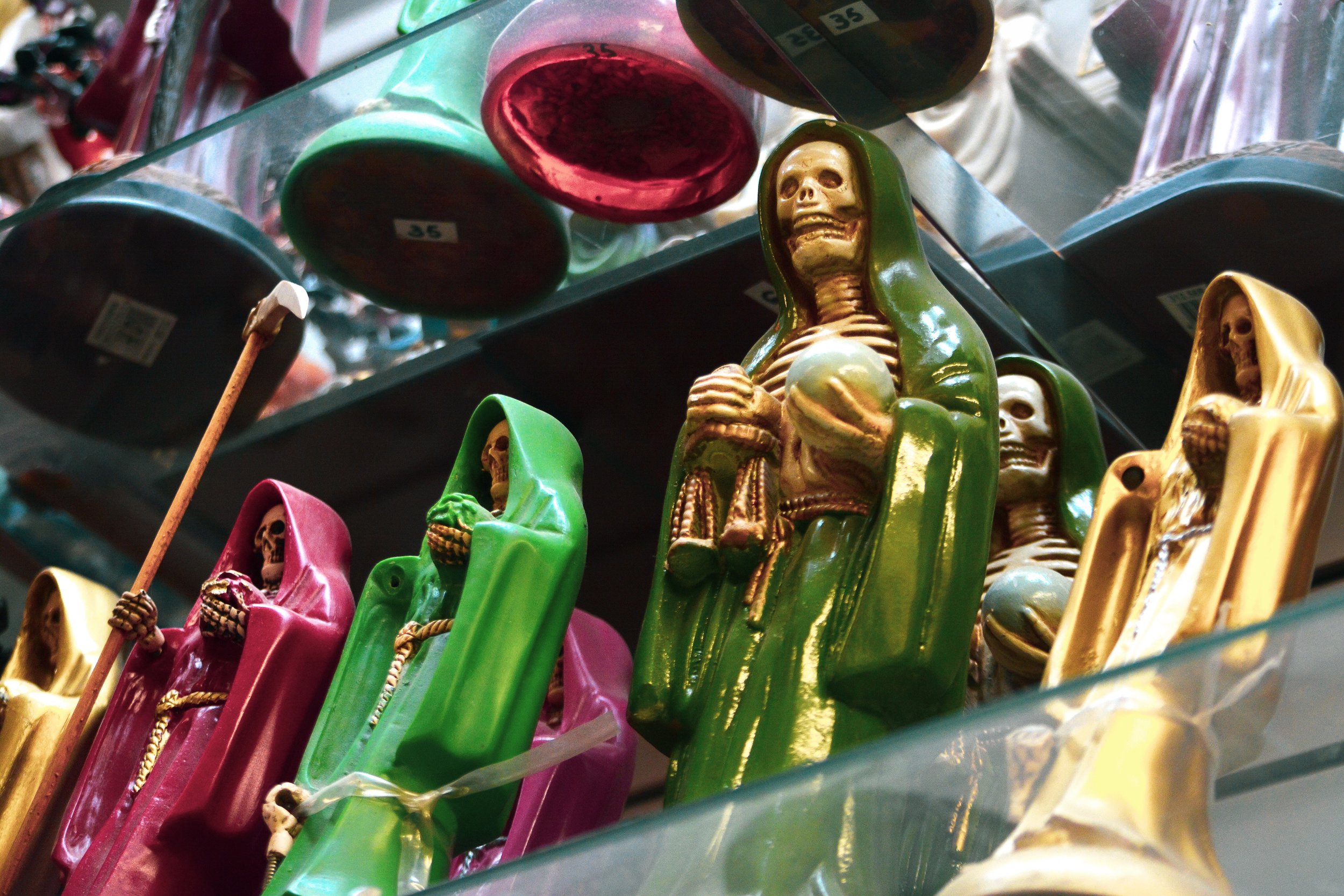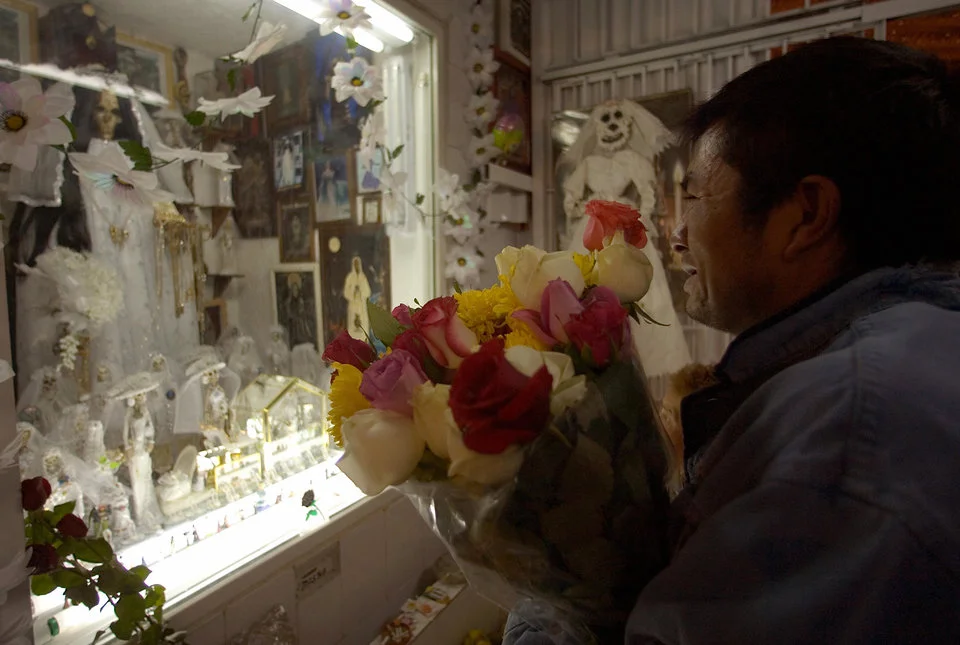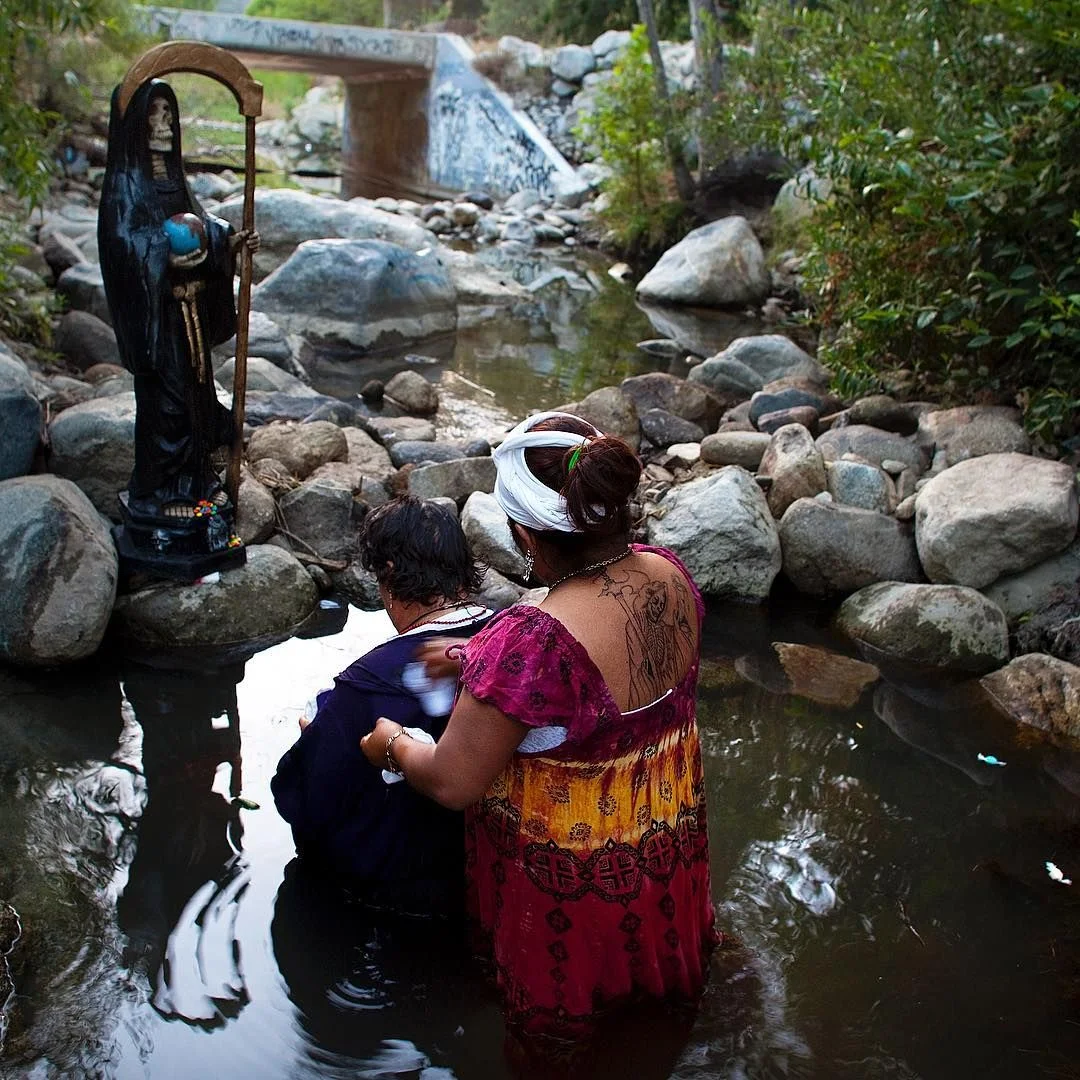La Dama de los Muertos
In botanicas (Latinx spiritual stores) and/or Mexican supermarkets such as Fiesta in Texas, you will eventually stumble upon an aisle filled with spiritual items and candles. As a young girl, I remember a figure that I found particularly interesting and frightening at the same time. It was a skeletal figure that I did not have any knowledge of — the figure of Santa Muerte (Holy Death).
In Mexican culture, death is not taboo nor necessarily sad. Mexicans attempt to look at death in the face and recognize it for what it is. Día De Los Muertos is a vibrant holiday in remembrance of the dead. This ideology shifts the focus from grieving for what was lost to celebrating who, or what, it was. For many, this absolves much of the fear surrounding death. Death is inevitable, random, and at times, inexplicable. The only thing that can be changed is how it's viewed.
Taken by Charlotte Carpenter at the Almacen and Ochun Botancia in Harlem.
There is a certain taboo surrounding Santa Muerte despite the fact that her existence predates the Spanish Inquisition. Much of the taboo could be attributed to her African and Afro-Caribbean origins as well as condemnation from the Catholic Church. Prior to colonization, the Indigenous people of Latin America had their own practices and beliefs. The Aztecs held the belief that there were thirteen paradises, or heaven, and nine levels of the underworld. In contrast to Western beliefs, the Aztecs viewed the way in which one dies as the determining factor for a individual’s journey in the afterlife, rather than their personal behavior. Those who died the most noble deaths, such as in childbirth or in battle, would certainly reach paradise. The arduous journey to the Aztec underworld of Mictlan lasted four years. Similar to the Egyptian beliefs, the Aztec dead were accompanied by a dog who guided them on their way.
Although the Spaniards were ruthless in their attempts to abolish what they viewed as sinful practices, these practices were obscured but not lost. Catholicism was often used as a tool to achieve these goals and the oppressed clung to their old beliefs to counteract the many changes and traumas occurring around them. However, time has shown that colonizers were not entirely successful. The Indigenous and African descendants found concealed ways to continue practicing their faith and eventually these two faiths were combined. The Yoruba traditions originated in Africa and spread throughout Latin America in different forms such as Santeria in Cuba, Palo Monte Mayombe in Brazil, and Haitian voodoo. These different forms have variations of the original Yoruba and continue to thrive in their respective countries. Catholicism and Yoruba traditions became mixed, as evident in the Spanish word, Santería, which means, worship of the saints.
Photo: Charlotte Carpenter / @charlotte_carpenter
Photo: Charlotte Carpenter/ @charlotte_carpenter
The spirit of Santa Muerte is alive in NYC. In Latino neighborhoods such as Washington heights, Harlem in Manhattan, and Flatbush and Bushwick in Brooklyn, botanicas and religious Caribbean influenced stores thrive. These botanicas offer many products for spiritual practices that range from oils, candles, and herbs. Many of the owners are spiritual advisors, also known as curanderos. Botanicas often have strong ties to the people in their community. They are considered safe spaces where people can come for spiritual readings and find solutions to ailments.
Throughout out my research, I found many anthropological studies, detailing the “cult” of Santa Muerte. Few of these are actually written by those who practice or learned from family traditions. They are mostly written by British scholars attempting to analyze the “other” of non-dominant and colonized culture. We may recognize Santa Muerte from our local stores in the Hispanic neighborhoods we grew up in but we never understood her, unless we were taught. Certain cultural beliefs that are retained and others left out like Santa Muerte can be due to the attempted erasure from colonizers, racism, and the Catholic church denouncing Santeria. Latinos have a wide range of ethnicities and ancestry with unique traditions; a way of preserving these practices is by continuing the discussion and exploration to help us understand our past and illuminate our futures.
Santa Muerte particularly resonates with people found on the outskirts and margins of society, those rejected by the Catholic Church and societal norms. That include sex workers, queers, and those involved in otherwise illicit hustles to make ends meet. She is a symbol of strength and protection for some of the most oppressed and outcast people. Those who felt persecuted found comfort in their own faith that was not associated with a hierarchical system and eternal shame. Santa Muerte is viewed beyond class, race, and sexual orientation. In the end, death is the great equalizer and the inescapable fate. Although Santa Muerte is still condemned by the majority of Catholic Churches, many practitioners do not see a distinction between her and the Catholic saints. In fact, some worship both the Virgin De Guadalupe and the Santa Muerte.
The Creation of an Altar of Santa Muerte
Sources
Kindrick, Jessica L. “Syncretism Embodied: The Afro-Caribbean Roots of La Santa Muerte.” Academia.edu, Feb. 2015, www.academia.edu/10999577/Syncretism_Embodied_The_Afro-Caribbean_Roots_of_la_Santa_Muerte.
Prower Tomás. La Santa Muerte: Unearthing the Magic & Mysticism of Death. Llewellyn Worldwide, 2015.
Prower Tomás. “4 Ways La Santa Muerte Empowers the Tribe.” Llewellyn Worldwide - Articles: The Patron Saint of LGBT Persons: 4 Ways La Santa Muerte Empowers the Tribe, Llewellyn Worldwide Ltd., www.llewellyn.com/journal/article/2533.
Rollin, Tracey. “Niña Verde, The Green Aspect of Santa Muerte .” Tracey Rollin, Tracey Rollin Properties, 15 July 2017, traceyrollin.com/nina-verde-the-green-aspect-of-santa-muerte/.
“Santería.” Cuban Santeria Tradition and Practices, Anywhere, Inc, www.anywhere.com/cuba/travel-guide/santeria.













The purple Santa Muerte is viewed as majestic with powerful psychic insight. She is associated with wisdom and magical spells. Pretty jewelry and flowers can be used as offerings. Sage is also a great herb to use.
Source: Santa Muerte History
Photo: Lucas Vallecillos / Alamy Stock Photo